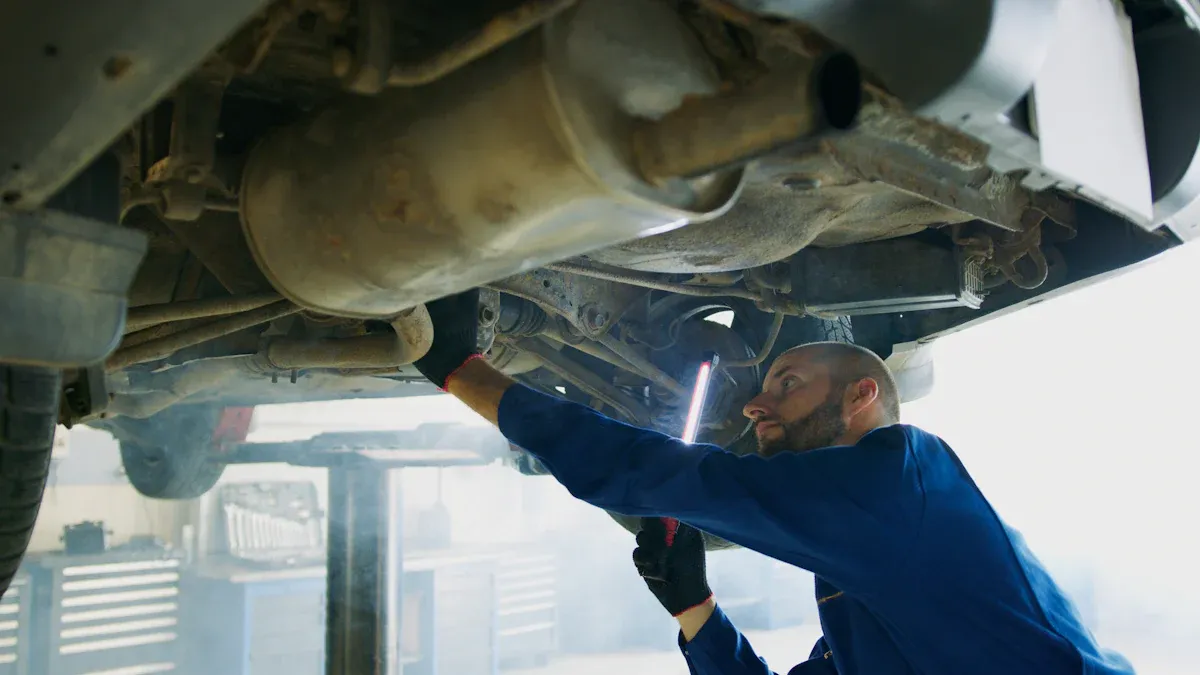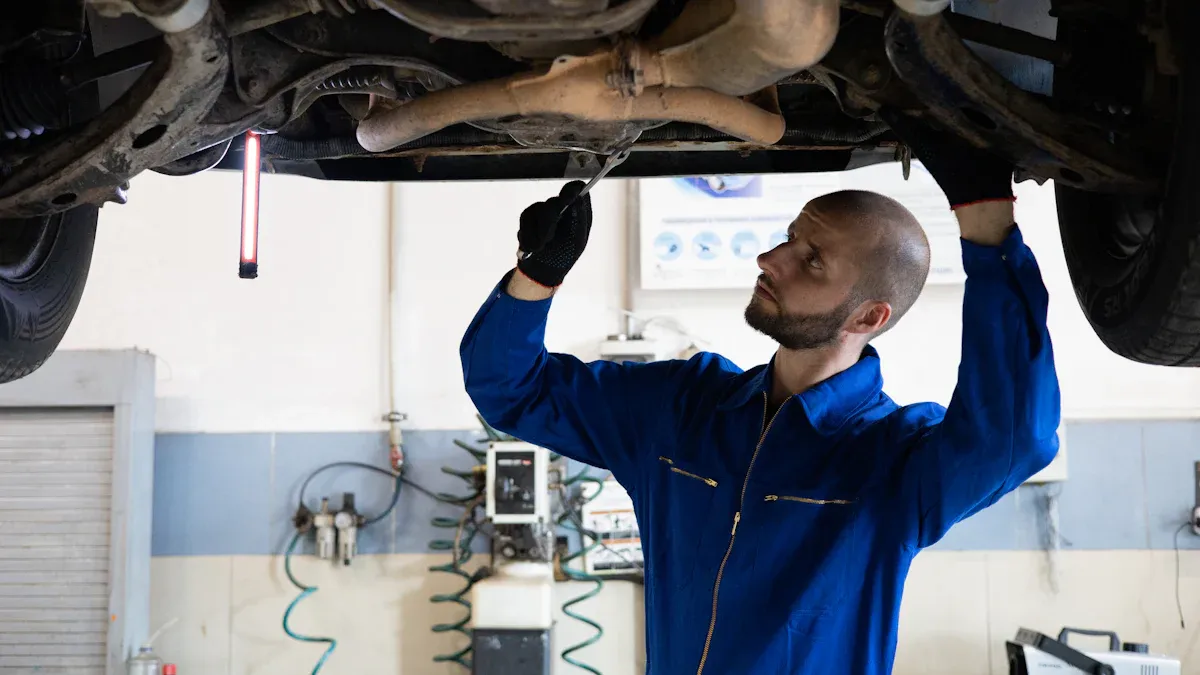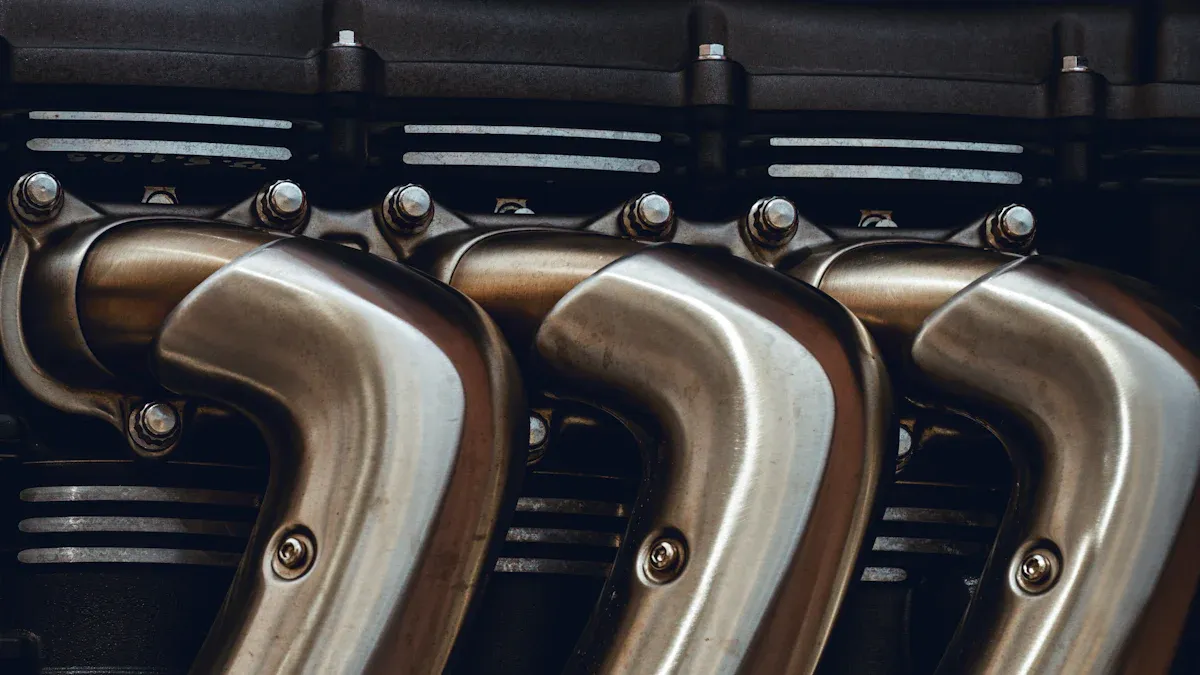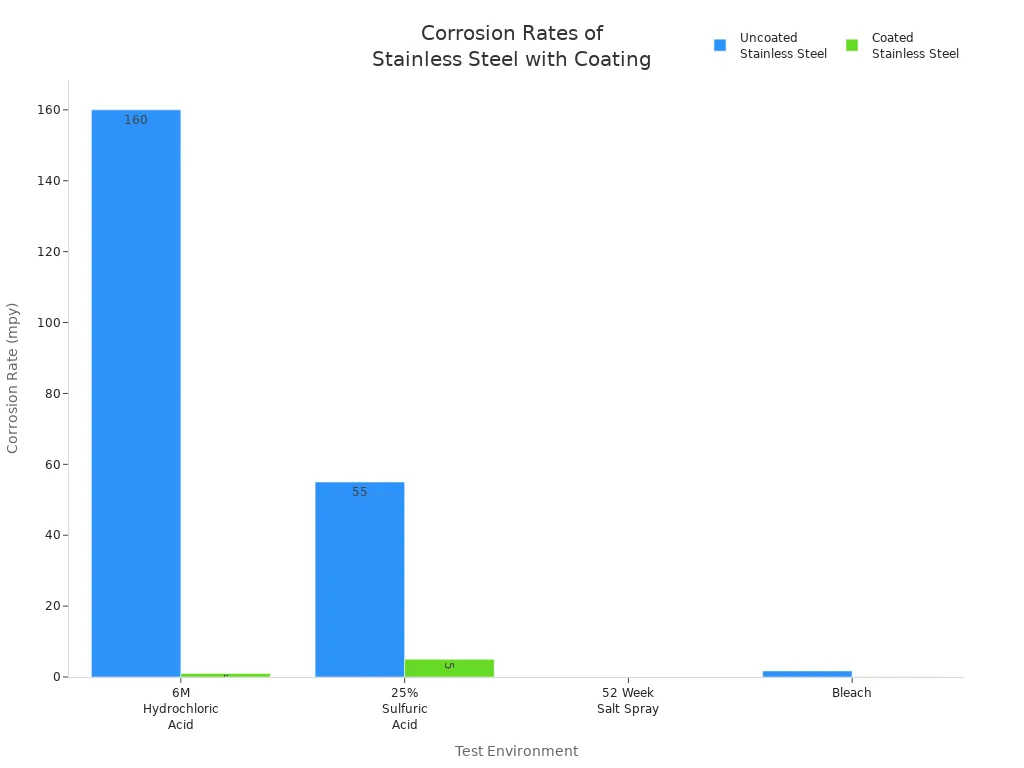close
Choose Your Site
Global
Social Media
Author: Site Editor Publish Time: 2025-07-12 Origin: Site









If you want your stainless steel exhaust pipe to last, regular care is the way to go. You can keep your stainless steel exhaust pipes looking sharp and working great by cleaning inside and out, checking for leaks, and tightening loose parts. With the right tips, you’ll prevent rust, corrosion, and ugly buildup. Many drivers see their stainless steel exhaust pipes last decades, sometimes even up to 100 years, just by sticking to a simple routine.
Regular cleaning and inspection keep your stainless steel exhaust pipe working well and lasting longer.
Use gentle cleaners and soft cloths to avoid scratches and protect the pipe’s finish.
Austenitic stainless steel pipes resist rust and heat, making them ideal for exhaust systems.
Check your exhaust every few months for leaks, rust, or damage to catch problems early.
Polish your exhaust pipe to maintain its shine and protect it from corrosion.
Avoid harsh chemicals and rough tools that can damage the metal surface.
Apply protective coatings and adjust maintenance by season to extend your exhaust’s life.
Seek professional help if you notice loud noises, smells, or visible damage to keep safe.
You want your car to run at its best, right? Regular maintenance of your stainless steel exhaust pipe plays a huge role in keeping your vehicle’s performance strong. When you keep the exhaust system clean and free of buildup, you help gases flow smoothly out of the engine. This smooth flow means your engine does not have to work as hard, which boosts horsepower and torque. You also get better fuel efficiency because the engine can breathe easier.
Stainless steel exhaust pipes handle high temperatures and resist rust, but only if you take care of them. If you let grime or rust build up, you risk leaks and blockages that hurt your car’s performance. You might notice your car feels sluggish or uses more gas. By cleaning and inspecting your exhaust regularly, you keep everything working together for optimal performance. You also help your car meet emission standards, which is more important than ever.
Tip: Always let your exhaust cool before cleaning. This keeps you safe and protects the pipe’s finish.
A shiny, clean exhaust pipe does more than just look good. It shows you care about your car and helps keep its value high. When you keep your stainless steel exhaust pipe free from stains, rust, and discoloration, you protect the metal and make your car more attractive to buyers. People notice when a car looks well cared for, and a sparkling exhaust pipe can be a real selling point.
If you ignore the pipe, it can start to look dull or even rusty. That hurts your car’s appearance and can lower its resale value. Regular cleaning and polishing keep your exhaust looking sharp and help you feel proud every time you see your car.
Nobody likes surprise repair bills. Taking care of your exhaust pipe saves you money in the long run. Small repairs, like fixing a clamp or welding a loose muffler, usually cost between $30 and $400. That is much less than replacing the whole exhaust system, which can run from $500 to $1,500. If you keep up with regular maintenance, you avoid big problems and expensive replacements.
Here’s a quick look at the difference:
Service Type | Cost Range (USD) | Notes |
|---|---|---|
Exhaust System Replacement | $500 - $1,500 | Full replacement, not including catalytic converters |
Exhaust Repair/Maintenance | $100 - $400 | Patching, welding, fixing clamps—much cheaper than new pipe |
By catching issues early, you also prevent extra fuel costs from a leaky or blocked exhaust. That means more money stays in your pocket, and your car keeps running at optimal performance.
When you hear about austenitic stainless steel pipes, you’re looking at the most popular type of stainless steel used in cars today. These pipes get their name from their special structure, called a face-centered cubic (FCC) microstructure. This structure comes from adding a lot of nickel (usually 8–20%) and chromium (16–26%) to the steel. You’ll also find that these pipes have low carbon content, which helps them weld easily and stay strong.
In the automotive world, you’ll often see these pipes labeled by a three-digit number, like 304 or 316. This system, set by the Society of Automotive Engineers (SAE), helps you know exactly what kind of steel you’re dealing with. For example, 304 stainless steel is a favorite for exhaust pipes because it stands up to tough conditions and resists rust.
Note: Austenitic stainless steel pipes are non-magnetic when they’re new and not heat-treated, so don’t be surprised if a magnet doesn’t stick.
Austenitic stainless steel pipes bring a lot to the table, especially for exhaust systems. Here’s what makes them stand out:
Excellent weldability: You can join these pipes using normal welding methods without much trouble.
High strength at high temperatures: They keep their shape and strength even when things get hot.
Great formability and ductility: You can bend and shape them without cracking.
Non-magnetic in the annealed state: They don’t attract magnets unless you work them hard.
Outstanding corrosion resistance: They don’t rust easily, even in salty or acidic environments.
Chemically inert: They don’t react with most chemicals you’ll find on the road.
Resist carbide formation: Special grades won’t form carbides, which means even better corrosion resistance.
If you look at grade 310, for example, you’ll see even more chromium and nickel, which means even better performance in extreme heat and tough conditions.
You might wonder why car makers and exhaust shops pick austenitic stainless steel pipes over other types. The answer comes down to performance and durability. Grade 304 stainless steel, for example, offers top-notch corrosion resistance. It stands up to rain, salty air, and road salt—things that can destroy other metals fast. You also get a pipe that welds easily, so repairs and custom work go smoothly.
Let’s compare 304 to another common grade, 409:
Feature | 304 Stainless Steel | 409 Stainless Steel |
|---|---|---|
Corrosion Resistance | Excellent | Good |
Appearance | Bright, polishable | Matte, rusts easily |
Cost | Higher | Lower |
Best Use | Performance, coastal | OEM, budget |
You pay a bit more for 304, but you get a pipe that looks better, lasts longer, and handles harsh environments. That’s why you see it in premium and aftermarket exhaust systems. If you want your exhaust to stay strong and shiny for years, austenitic stainless steel is the way to go.

Before you start working on your stainless steel exhaust pipe, you need the right tools and materials. Using the proper gear makes cleaning easier, keeps your pipe looking sharp, and helps you avoid damage. Let’s break down what you’ll need for the best results.
You want your exhaust pipe to shine, so picking the right cleaning solutions is key. Not all products are safe for stainless steel, and some can actually cause more harm than good. Here’s what you should keep in your garage:
Use quality metal polishes made for stainless steel to restore the finish and remove stains.
Soft cotton cloths work best for applying cleaning solutions. They won’t scratch the surface like rough towels or brushes.
Stick with soapy water for regular cleaning. It’s gentle and effective for removing dirt and grime.
For heavy-duty cleaning, try rapidly evaporating solvents like brake cleaner or acetone. These help break down stubborn carbon deposits without leaving residue.
Scotch brite pads (red or gray) are great for restoring brushed finishes and removing stuck-on material. Use them gently to avoid scratching.
If you want extra protection, apply a light spray like ACF-50 or a ceramic protectant after cleaning. This helps prevent corrosion.
Always test new cleaning solutions on a small area first. Some products can react with coatings or finishes.
Avoid acid-based cleaners and never clean a hot exhaust pipe. Let it cool down first.
Tip: Start with the least aggressive cleaning method. If you need more power, move up to stronger cleaning solutions only when necessary.
Once you finish cleaning, you’ll want to bring out that mirror shine. The right tools make a big difference when you polish your exhaust pipe. Here are some favorites among car enthusiasts:
Blue Magic polish is a top pick for both initial and maintenance polishing. Apply it with a rag using a back-and-forth motion.
Autosol metal polish works fast on heat stains, but you may need to repeat the process since discoloration comes back over time.
For tough spots, 0000 steel wool combined with a rubbing compound (like Turtle Wax Renew Rx or even toothpaste) can help restore shine.
If you want to mimic the factory brushed look, use 220 grit sandpaper. Sand in one direction for the best results.
Electropolishing is a professional option that gives a long-lasting finish, but most people stick with manual methods at home.
Some people swear by Delboy’s chrome polishing technique using mutton cloth, though it takes a bit of elbow grease.
Note: Oxide discoloration is normal for stainless steel exhausts. You’ll need to polish them regularly to keep that fresh look.
Safety should always come first when you’re cleaning or polishing your exhaust pipe. Stainless steel edges can be sharp, and cleaning solutions may irritate your skin or eyes. Here’s what you should wear:
Gloves protect your hands from cuts, scrapes, and harsh cleaning solutions.
Safety glasses with side shields keep your eyes safe, especially if you’re using scotch brite pads or sandpaper.
Wear protective clothing to avoid getting cleaning products on your skin or ruining your clothes.
Make sure you know how to use your safety gear properly. It only works if you wear it the right way.
Check your gloves and glasses before each use. Replace them if they’re damaged or worn out.
Remember: Taking a few minutes to gear up can save you from painful injuries or accidents.
Keeping your stainless steel exhaust pipe in top shape takes more than just a quick wipe. You need the right approach for both the outside and inside. Here are some practical tips to help you get the best results and keep your stainless steel exhaust pipes looking and performing their best.
Start with the basics. Always make sure your exhaust is cool before you begin. You don’t want to burn your hands or damage the finish. Begin by washing the outside of your stainless steel exhaust pipe with soap and water. Use a soft cloth or sponge to remove loose dirt and grime. For stubborn grease or road tar, a contact cleaner or a tar remover like Tarminator works well. Spray it on, let it sit for a few minutes, and then wipe it off.
If you see bluing or discoloration, grab a red Scotch Brite pad. Gently rub the affected areas. This pad helps remove tough stains without scratching the metal. For heavy buildup, you can use a degreaser. Apply it, let it soak as directed, and then scrub with steel wool in small circles. Wipe everything down with a microfiber cloth to remove any leftover dust or moisture.
Tip: Block the end of the exhaust before cleaning to protect the internal muffler packing from getting wet or dirty.
Once you’ve removed the grime, it’s time to bring out the shine. Apply a metal polish made for stainless steel. Brands like Mothers or Semichrome work great. Put a small amount on a clean rag or steel wool and rub it onto the pipe. Let the polish sit for a few minutes, then buff it off with a fresh microfiber cloth. This step restores the shine and helps protect the surface.
Avoid using chrome polish on stainless steel exhaust pipes. Chrome polish can damage the finish and leave streaks. If you want extra shine, a light spray of WD-40 can give your stainless steel tailpipes a glossy look. For long-term protection, apply a metal sealant after polishing. This creates a barrier against moisture and road salt.
Note: For really tough buildup, you can carefully use a razor blade or a stainless wire brush. Work slowly and gently to avoid scratching the pipe.
The inside of your exhaust collects soot and carbon deposits over time. You’ll want to clean this out to keep your stainless steel exhaust pipes working efficiently. Start by gathering gloves, soap and water, a rag, and a brush that fits inside the pipe. Scrub the inside with soapy water to loosen dirt and smoke deposits.
For heavy soot, spray a degreaser inside the pipe. Let it sit as the product recommends. Use steel wool or a stiff brush to scrub away the loosened buildup. Repeat if needed until the inside looks clean.
A pressure washer can help break down stubborn carbon deposits inside the pipe. If you don’t have one, running a dry rag through the pipe works too. Just remember, soot will build up again quickly, so regular cleaning is key. After using water, dry the inside of the pipe as soon as possible. You can reinstall the exhaust and run the engine for a few minutes to help evaporate any leftover moisture. This step helps prevent rust and keeps your stainless steel exhaust pipe in good condition.
Never skip rinsing after cleaning. Use clean water to wash away any leftover soap, degreaser, or polish. This step prevents residue from causing stains or corrosion. After rinsing, dry the exhaust thoroughly with a microfiber cloth. Pay special attention to seams and joints where water can hide. Routine rinsing and drying stop rust and oxidation before they start.
Tip: Make rinsing and drying part of your regular cleaning routine. Your stainless steel exhaust pipes will thank you with a longer life and a better shine.

You want your stainless steel exhaust pipe to last as long as possible. That starts with a good inspection routine. Every few months, take some time to check your exhaust system for early signs of trouble. Here’s a simple step-by-step list you can follow:
Start your car and listen for strange noises. Hissing or popping sounds can point to leaks.
Look closely at the exhaust pipes, mufflers, and tailpipes. Check for cracks, holes, rust, or corrosion. You might need to lift your car for a better view.
Remove any heat deflectors or muffler covers. This lets you see hidden spots where damage can start.
Use a flashlight or inspection camera to check inside the pipes and mufflers. Look for bulges, wrinkles, or thin spots.
Gently press on any thin-looking areas with an awl to see if the metal feels weak.
Spray soapy water on joints and welds. If you see bubbles while the engine runs, you’ve found a leak.
Watch for gray or black soot, yellow stains, or loose parts inside the muffler. These are signs of leaks or damage.
Tip: Make inspection part of your regular maintenance routine. Catching problems early saves you money and keeps your exhaust working its best.
How often should you clean your stainless steel exhaust pipe? That depends on where you drive and the weather. If you live near the ocean or in a place with lots of road salt, you need to clean more often. Experts suggest a regular cleaning schedule of at least once every three months. In harsh conditions, aim for once a month.
Stick to mild soap and water for most cleaning jobs. Use a dedicated exhaust cleaner or metal polish for extra shine. Don’t forget to rinse and dry the pipe after every wash. If you notice stubborn carbon buildup, schedule a professional cleaning once or twice a year. This keeps your exhaust looking great and helps it last longer.
Note: A regular cleaning schedule helps prevent rust and corrosion. Your exhaust will thank you with a longer life and better performance.
Keeping track of your regular maintenance is easier than you think. Start a simple log or use your phone’s calendar to note each inspection and cleaning. Write down the date, what you did, and any problems you found. This way, you never forget when it’s time for your next checkup.
A maintenance calendar helps you spot patterns, like recurring leaks or rust spots. You can also show your records if you ever sell your car. Buyers love to see proof of regular maintenance. It shows you care and helps your car keep its value.
Pro Tip: Consistent upkeep and good records mean your stainless steel exhaust pipe will stay strong, shiny, and trouble-free for years.
You might think that using strong chemicals will make your stainless steel exhaust shine faster. In reality, harsh cleaners can do more harm than good. Many products contain acids or bleach that eat away at the metal. Over time, these chemicals can cause pitting, dull spots, or even discoloration. If you use the wrong cleaner, you may notice your exhaust losing its shine or developing rough patches that are hard to fix.
Stick with gentle cleaning solutions made for stainless steel. Always check the label before you start. If you are unsure, test a small hidden area first. Remember, a little patience with the right product goes a long way. Your exhaust will thank you with a longer life and a better look.
Tip: Never mix different cleaning products. Some combinations can create toxic fumes or damage your exhaust.
It’s easy to forget about your exhaust when life gets busy. Skipping regular maintenance, though, can lead to big problems. Cracks and leaks often start small, but they grow quickly if you ignore them. Extreme heat, road salt, and moisture all speed up corrosion. When cracks form, toxic gases like carbon monoxide can leak into your car’s cabin. This is not just a small issue—it’s a serious safety risk.
You might also notice your engine running rough or making more noise. Small leaks can cause your car to fail emissions tests, which means fines or trouble with registration. If you let things slide, you could end up with expensive repairs or even engine damage. Regular cleaning and inspections help you catch problems early and keep your exhaust working safely.
Don’t wait for a problem to get worse. A quick check every few months can save you money and keep you safe.
Choosing the right tools for cleaning makes a huge difference. Many people grab steel wool or wire brushes, thinking they will scrub away dirt fast. These tools actually scratch the surface of your stainless steel exhaust. Scratches make the metal look dull and give dirt and grime more places to hide. Even worse, tiny scratches can trap moisture and lead to rust.
Instead, use soft nylon brushes or microfiber cloths. These tools clean well without damaging the surface. If you need to tackle tough spots, try a red Scotch Brite pad, but use it gently. Avoid anything that feels rough or sharp. Your exhaust will stay shiny and smooth with the right approach.
Tool Type | Safe for Stainless Steel? | Effect on Surface |
|---|---|---|
Steel Wool | ❌ No | Scratches, dullness |
Wire Brush | ❌ No | Microscopic damage |
Nylon Brush | ✅ Yes | Gentle, safe cleaning |
Microfiber Cloth | ✅ Yes | No scratches |
Note: The right tools make cleaning easier and help your exhaust last longer.
You want your stainless steel exhaust to last as long as possible, right? Protective coatings can make a huge difference. These coatings act like a shield, blocking moisture, chemicals, and road salt from reaching the metal. You have several options, each with its own strengths. Here’s a quick look:
Coating Type | Key Benefit | Common Use |
|---|---|---|
Epoxy Coatings | Chemical resistance, durable | Chemical tanks, pipelines |
Polyurethane Coatings | Abrasion and UV resistance | Exterior piping, structural |
PTFE (Teflon) Coatings | Non-stick, chemical resistance | Food processing, pharmaceutical |
Ceramic Coatings | High temperature and wear resistance | Exhaust systems, furnace parts |
Powder Coatings | Durable and aesthetic | Architectural, general industrial |
Rubber Linings | Abrasion and chemical resistance | Slurry lines, acid tanks |
Zinc Coatings | Sacrificial corrosion protection | Exterior non-stainless metals |
Specialized silicon-based coatings like Silcolloy® and Dursan® take things even further. They form an inert barrier that keeps out corrosive agents and oxygen, even at high temperatures. This means your exhaust stays protected, needs less maintenance, and lasts much longer.
How effective are these coatings? Take a look at this chart comparing corrosion rates:

You can see that coated stainless steel resists corrosion far better than uncoated steel, even in harsh environments like acid or bleach. If you want to extend the life of your exhaust, adding a protective coating is a smart move.
Every season brings new challenges for your exhaust system. In winter, road salt and moisture can speed up corrosion. In summer, high temperatures and dust can cause buildup. You should adjust your maintenance routine to match the season.
In winter, rinse your exhaust more often to wash away salt and grime.
In spring, check for rust or damage left by winter roads.
In summer, clean off dust and inspect for heat discoloration.
In fall, look for leaves or debris that might block airflow.
Tip: Make a seasonal checklist. This helps you stay on top of maintenance and catch problems early.
Sometimes, you need a professional to keep your exhaust in top shape. If you hear loud noises, notice strange smells, or feel vibrations, it’s time to get help. Professionals have the right tools and know-how to fix complex problems.
Here are some signs you shouldn’t ignore:
You hear excessive noise or rumbling.
You notice a drop in power or fuel efficiency.
You smell exhaust fumes inside your car.
You see rust, cracks, or leaks on the exhaust.
You feel unusual vibrations while driving.
If you spot any of these, don’t wait. Weld failures or severe corrosion often mean repairs won’t last, and you might need a full replacement. A professional can inspect, repair, or replace your system to keep you safe and your car running smoothly.
Regular maintenance keeps your stainless steel exhaust pipes looking sharp and running strong. When you clean, inspect, and protect your pipes, you get big rewards:
Longer lifespan thanks to corrosion resistance and high-temperature durability
Fewer costly repairs or replacements
Better performance and fuel efficiency
A car that holds its value and looks great
Stick to gentle cleaners, dry your pipes after washing, and avoid harsh chemicals. Make these habits part of your routine, and you’ll enjoy a trouble-free exhaust for years to come.
You should clean your exhaust pipe every three months. If you drive in salty or wet conditions, clean it once a month. Regular cleaning keeps rust and buildup away.
Most household cleaners are too harsh. Stick with mild soap and water or a cleaner made for stainless steel. Always check the label before you use anything new.
Don’t panic. Light rust comes off with a Scotch Brite pad or metal polish. For deeper rust, use a stainless steel cleaner. If rust keeps coming back, check for leaks or trapped moisture.
Yes, WD-40 works well for a quick shine. Spray a little on a microfiber cloth and wipe the pipe. Don’t use it as your only cleaner, though. It’s best for finishing touches.
You can use a pressure washer for the outside. Keep the nozzle at a safe distance. Don’t spray directly into the pipe. Too much water inside can cause rust or damage.
Rinse your exhaust more often to remove salt and grime.
Apply a metal sealant before winter starts.
Park in a garage if possible.
Dry the pipe after every wash.
Look for these signs:
Loud noises or rattling
Strong exhaust smells inside your car
Visible cracks or holes
Sudden drop in performance
If you notice any of these, call a mechanic right away.